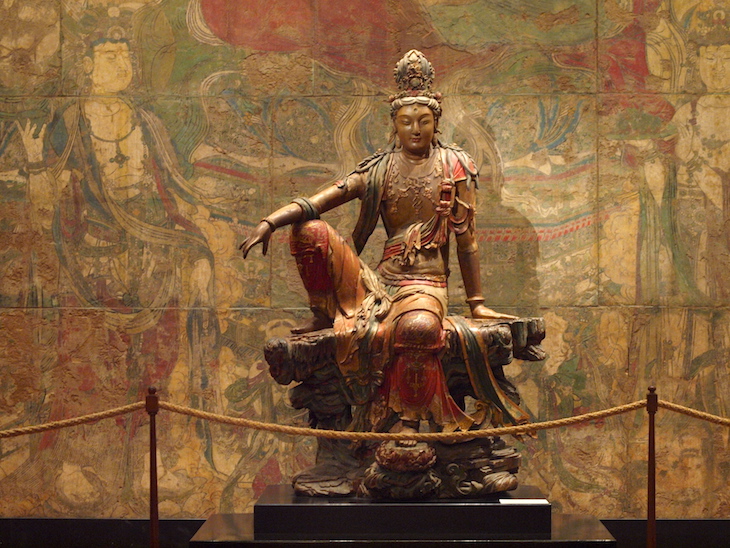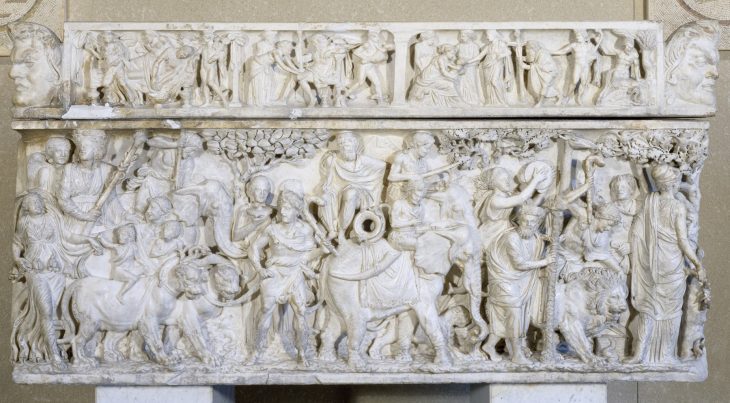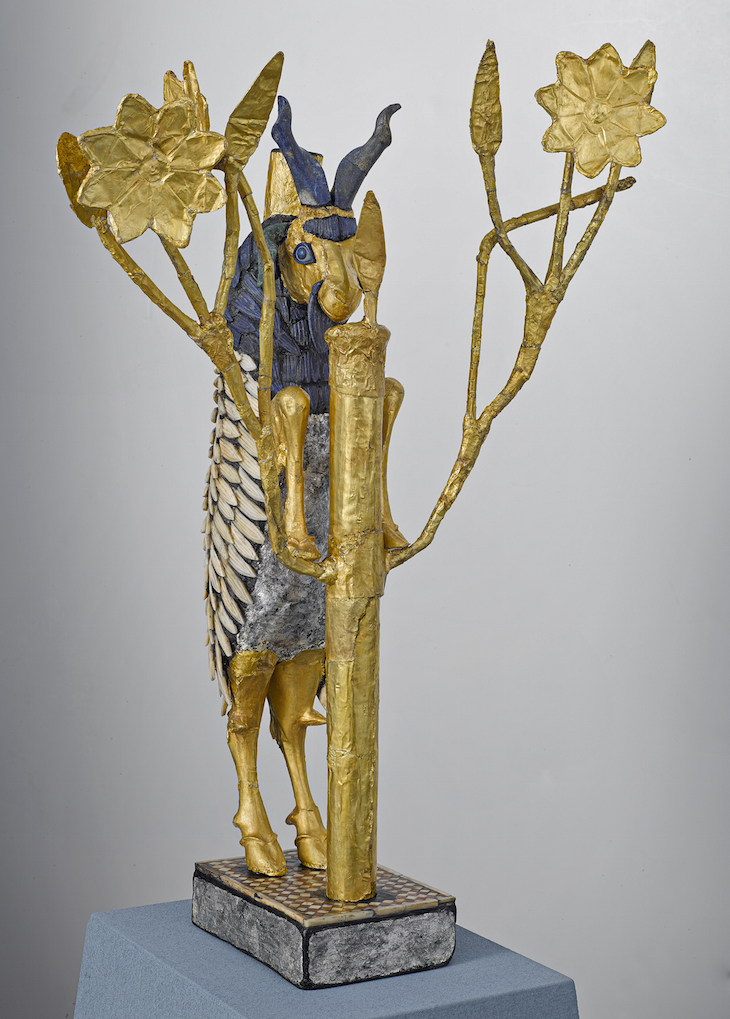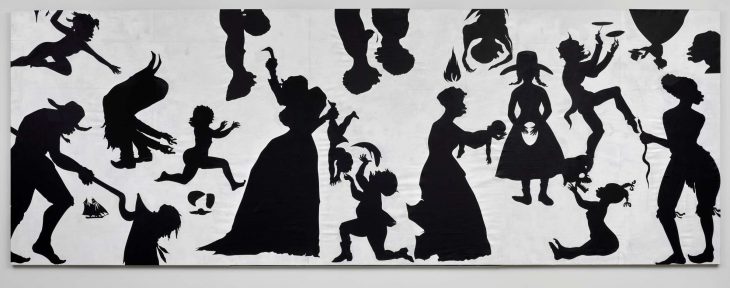Apollo recently asked leading figures and in the museum and art worlds from the UK and from the Netherlands to pick out five items from public collections that they felt every schoolchild in their country ought to see. Below, the directors of five major US museums pick out the objects that should be essential viewing for American schoolchildren.
Melissa Chiu
Director of the Hirshhorn Museum and Sculpture Garden

Guanyin of the Southern Sea (c. 10th-11th century), China. Nelson-Atkins Museum of Art, Kansas City
Guanyin of the Southern Sea (c. 10th–11th century), China
Nelson-Atkins Museum of Art, Kansas City
We more often think of painting, poetry and calligraphy as the key media of Chinese art, but this sculpture is widely touted as one of the best examples currently located outside China. It helps with an understanding of China’s 5,000 years of culture, not to mention its connections across the ancient world, in this case with India through Buddhism. One of the greatest geopolitical shifts on the horizon is China’s rise in importance. If you want to understand the country you need to understand its history and culture.
The Rothko room
National Gallery of Art, Washington, D.C.
To see so many works by Mark Rothko together here is a delight; it’s an immersion in color and ethereality. One of America’s great post-war painters.
Detroit Industry Murals (1932–33), Diego Rivera
Detroit Institute of Art
This is truly a historical series of works – the car industry in action. A chronicle of the early 20th century by a Mexican muralist.
Fountain (1917/1950), Marcel Duchamp
Philadelphia Museum of Art
There is no artist more important to understanding contemporary art today than Duchamp. This work is all about the idea; the artist declared that a factory-made urinal was a piece of art, or as he called it, a readymade.
Les Demoiselles D’Avignon (1907), Pablo Picasso
Museum of Modern Art, New York
Painting at this time was still tied to an idea of recording reality. This work ushered in an understanding of pictorial distortion and a fragmented picture plane.
Michael Govan
Director of the Los Angeles County Museum of Art

Theatrical poster for Blade Runner (1982) by John Alvin. © 1982 The Ladd Company
Blade Runner (1982), directed by Ridley Scott
We sometimes forget that popular movies can become lasting artefacts of art history. Ridley Scott’s original Blade Runner, based on Philip K. Dick’s novel Do Androids Dream of Electric Sheep?, has the epic beauty that sometimes only film can convey. Its content is especially prescient as we redefine what humanity means, as distinguished from machines that have begun to exceed us in strength and intelligence.
The Two Fridas (1939), Frida Kahlo
Museo de Arte Moderno, Mexico City
This monumental double self-portrait communicates the artist’s strength as well as her vulnerability and pain. Few paintings capture an inner humanity in visible form as potently as some of Frida’s best works, like this one.
Injustice Case (1970), David Hammons
Los Angeles County Museum of Art
This work refers to a specific event – the story of Bobby Seale, a co-founder of the Black Panthers who was put on trial in 1968, charged with conspiracy – but its feeling and meaning, unfortunately, remain as relevant today. A work on paper, Hammons’s body print is as impactful as any painting or sculpture.
Innocent Love (1999), Agnes Martin
Dia Art Foundation, New York
Abstraction can evoke feelings and ideas that have no equivalent in words or figures. Agnes Martin made art, as she said, that was ‘wordless and silent’. Her minimal and sublime series of paintings titled Innocent Love expresses a sense of well-being and the potential perfection of the mind.
The Lightning Field (1977), Walter De Maria
Western New Mexico
An image of nature can never compete with the power of nature itself. But certain artists have been able to channel and heighten the experience of the landscape through art. This is especially true of Walter De Maria’s land art masterpiece, The Lightning Field. In the vast space of the New Mexico desert, the sculpture (also in Dia’s collection) mediates our relationship to the environment rather than trying to depict it.
Julia Marciari-Alexander
Director of the Walters Art Museum

Sarcophagus with the Triumph of Dionysus (c. 190 AD), Rome. Courtesy Walters Art Museum
Sarcophagus with the Triumph of Dionysus (c. 190 AD), Rome
Walters Art Museum, Baltimore
The most spectacular among a group of extraordinary sarcophagi from the Roman era, this object is a mastery of carved storytelling. Sculpted in high relief, the story of the procession of Bacchus through India not only conveys the genius of the artisans working the marble but their imagination and knowledge of a wide and exotic world: among the animals depicted in the processional are panthers, lions, elephants, and even a giraffe.
A Sunday on La Grande Jatte – 1984 (1884/86), Georges Seurat
Art Institute of Chicago
Among the most beautiful and intriguing paintings in American collections, this work still enthrals today, some 140 years after it was painted. Life-size in scale, the work speaks directly to the paradoxical experience of sociable isolation – a phenomenon ever more inherent in today’s electronic world –and thereby draws a comparison between contemporary life, in which we continue doggedly to pursue leisure and outdoor experiences, and urban life in late 19th-century Europe.
Rosie the Riveter (1943), Norman Rockwell
Crystal Bridges Museum of American Art, Bentonville
Although a different image of Rosie the Riveter is better known and more widely circulated today (Westinghouse Electric’s internal poster ‘We Can Do It!’) it was this painting by Norman Rockwell that was reproduced as the cover of the Saturday Evening Post on 29 May, 1943. Circulated to almost three million households, Rockwell’s image was the most pervasive tribute to and reminder of the contributions of women to the US war efforts in the Second World War. As a reminder of the role fine and popular art play in both creating and challenging stereotypes set forth by society, it has never been more relevant.
Freedom, A Fable: A Curious Interpretation of the Wit of a Negress in Troubled Times (1997), Kara Walker
Multiple collections across the US
Kara Walker is among the greatest artists of late 20th and early 21st century America. She creates art that is beautiful, challenging, and often ephemeral. Selecting the work from her tremendous oeuvre is nigh-unto-impossible, but here I’ve chosen a limited edition artist’s book. Walker’s use of silhouettes and her powerful manipulation of narrative toy with how illustrated books advance or rupture corrosive belief systems.
Isabella Stewart Gardner Museum, Boston
There are few more exciting museum experiences in the US than discovering the exceptional and magnificent works of art in the stunning – and frankly a bit wacky – setting of the Gardner museum. From Chinese reliefs to paintings by Titian, Veronese, and Sargent (I love his El Jaleo), the works of art in this purpose-built palazzo reveal at every turn the personality of its founder and creator Isabella Stewart Gardner, known as Mrs Jack.
Julian Siggers
Director of the Penn Museum

Ram in the Thicket (2600–2400 BC), Ur, southern Iraq. Courtesy Penn Museum
Ram in the Thicket (2600–2400 BC), Ur, southern Iraq
Penn Museum, Philadelphia
The ‘Ram in the Thicket’ is one of the great masterpieces of the ancient world. Crafted from a combination of gold, lapis lazuli, and silver, the statuette shows a goat nibbling on the leaves of a small tree. It is a staggering 4,500 years old, and its artistic sophistication is centuries before its time.
Human-Headed Winged Bull (c. 721–05 BC), Assyria, northern Iraq
Oriental Institute, Chicago
This sculpture is enormous – one of the largest of its kind in the world. One of a pair that flanked the entrance to the throne room of Sargon II, King of Assyria, it depicts a lamassu: a protective spirit with a human head, the body and ears of a bull, and the wings of a bird.
Fragment of a Queen’s Face (c. 1353–36 BC), Egypt
Metropolitan Museum of Art, New York
This is one of the most beautiful pieces of sculpture I’ve ever seen, made all the more beautiful, to me, by its fragmentary nature. Thousands of years after it was carved, we are left to wonder what the full piece would have looked like – speculation that speaks to the essence of archaeology. It probably depicts a royal woman from the 14th century BC, perhaps Queen Tiye (mother of the pharaoh Akhenaten) or one of Akhenaten’s wives, Queen Nefertiti or Queen Kiya.
Clovis points (c. 9000 BC)
Penn Museum, Philadelphia
The primary weapon of the first Americans, the Clovis point was used to hunt megafauna like mastodons near the end of the Ice Age – a fact that can spark young imaginations.The examples in the museum represent the type after which all others are named. These spearheads are not only one of the first weapons used by man but also pieces of complex sculpture. They took great skill and dexterity to produce.
Attic Panathenaic Amphora (500–480 BC), attributed to Kleophrades
J. Paul Getty Museum, Los Angeles
This amphora would have been filled with olive oil and presented as a prize in the Panathenaic Games (a religious festival honouring the city’s patron goddess Athena every four years, in a sort of regional version of the ancient Olympic Games). This vase would have been presented to the winner of a four-horse chariot race. For schoolchildren familiar with today’s Olympics, this precursor to the familiar medals would be fascinating.
Gary Tinterow
Director of the Museum of Fine Arts, Houston

Slaughter of the Innocents (They Might be Guilty of Something) (2016), Kara Walker. Courtesy Museum of Fine Arts, Houston; © Kara Walker
Slaughter of the Innocents (They Might Be Guilty of Something) (2016), Kara Walker
Museum of Fine Arts, Houston
Schoolchildren are adept at discerning the narratives in works such as this magisterial parable; 150 years after Lincoln, Kara Walker reminds us that the pernicious stain of racism continues to taint American culture.
Abraham Lincoln (1920), Daniel Chester French
Lincoln Memorial, Washington, D.C.
It has always been inspiring to stand in the presence of this effigy, but now, more than ever before, schoolchildren must be reminded what a truly great leader is and can be. There is no better example than Lincoln, who made the ultimate sacrifice in an effort to unite the country with the promise of freedom and justice for all people.
The Court of Kayumars, from the Shahnameh of Shah Tahmasp I (c. 1522), Sultan Muhammad
Aga Khan Museum, Toronto
I would take my students on a field trip to Toronto to see this miracle of miniature painting, one that continues to fascinate when greatly magnified. It features extraordinary details of flora and fauna, as well as a rainbow coalition of human beings from every continent and culture, much as one sees on the streets of Toronto.
The Bedroom (1889), Vincent van Gogh
Art Institute of Chicago
Every child can relate to the representation of a bedroom as a universe of the mind, at once safe house and launching pad of the imagination.
Nkisi n’kondi (19th century), Kongo people, Republic of the Congo or Angola
Metropolitan Museum of Art, New York
In the society of the Kongo people, agreements and contracts were concluded by hammering a nail into a power figure, a witness to and guardian of the agreement, and perpetual reminder that civilisation requires compromise and respect for law and social conventions.
Lead image: used via Creative Commons under a GNU Free Documentation licence














![Masterpiece [Re]discovery 2022. Photo: Ben Fisher Photography, courtesy of Masterpiece London](http://zephr.apollo-magazine.com/wp-content/uploads/2022/07/MPL2022_4263.jpg)
Suzanne Valadon’s shifting gaze